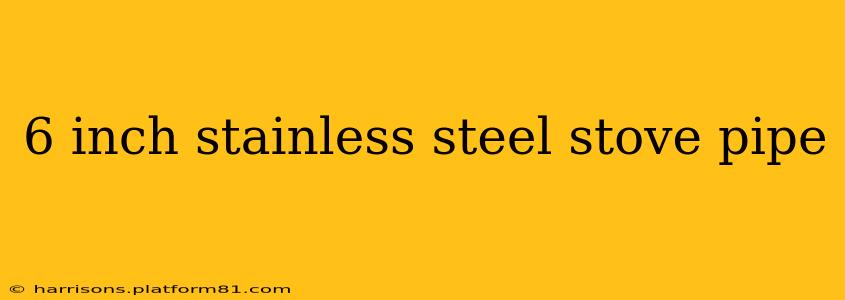Choosing the right stove pipe is crucial for safe and efficient operation of your wood-burning stove or appliance. A 6-inch diameter stainless steel stove pipe is a popular choice, offering durability and aesthetics. This guide will delve into the specifics of 6-inch stainless steel stove pipe, addressing common questions and concerns.
What are the benefits of using 6-inch stainless steel stove pipe?
Stainless steel stove pipe offers several advantages over other materials like galvanized steel. Its corrosion resistance ensures longevity, preventing rust and extending the lifespan of your chimney system. The smooth interior surface minimizes creosote buildup, a significant fire hazard. Aesthetically, stainless steel offers a cleaner, more modern look compared to other options. The 6-inch diameter is a common size for many wood-burning appliances, ensuring compatibility.
What are the different types of 6-inch stainless steel stove pipe?
Several types of 6-inch stainless steel stove pipe exist, each with its own characteristics:
- Single-wall: This is the most economical option, but it requires additional insulation for safety and to meet building codes. It’s generally only suitable for short runs.
- Double-wall: This type offers superior insulation, reducing the risk of fire hazards and heat loss. It's a safer and more efficient choice for longer runs and applications closer to combustible materials.
- Triple-wall: Provides the highest level of insulation and is ideal for installations where maximum safety and efficiency are paramount. Often used in challenging installations.
How do I choose the right gauge of 6-inch stainless steel stove pipe?
The gauge of the stainless steel refers to its thickness. A lower gauge number indicates thicker, more durable metal. While thicker gauges offer greater strength and longevity, they also come at a higher price. The appropriate gauge depends on the specific application and local building codes. Consult your local building codes and stove manufacturer's instructions for recommendations on the correct gauge.
What are the installation requirements for 6-inch stainless steel stove pipe?
Proper installation of 6-inch stainless steel stove pipe is crucial for safety. Always adhere to the manufacturer’s instructions and local building codes. This typically includes:
- Proper clearances: Maintaining sufficient clearance from combustible materials is essential to prevent fire hazards. Check your local codes and stove manufacturer's instructions for specific clearance requirements.
- Correct connectors and sealing: Use high-quality connectors and ensure all joints are properly sealed to prevent leaks and drafts.
- Support structure: The stove pipe needs proper support to prevent sagging and potential damage.
- Inspection: Regular inspection of the stove pipe for any signs of damage or creosote buildup is crucial for safety.
What are the common sizes and lengths available for 6-inch stainless steel stove pipe?
6-inch stainless steel stove pipe is commonly available in various lengths, typically ranging from 2 feet to 4 feet. Specific lengths and availability may vary depending on the supplier.
How much does 6-inch stainless steel stove pipe cost?
The cost of 6-inch stainless steel stove pipe varies based on factors such as length, gauge, type (single, double, or triple-wall), and supplier. It's best to contact local suppliers for accurate pricing information.
How do I clean my 6-inch stainless steel stove pipe?
Regular cleaning of your 6-inch stainless steel stove pipe is essential for optimal performance and safety. Creosote buildup can be a serious fire hazard. The frequency of cleaning depends on usage; however, annual cleaning is typically recommended. Consult a chimney sweep professional for advice and assistance in cleaning your stove pipe.
This information is for general guidance only. Always consult local building codes, your stove manufacturer's instructions, and a qualified professional for specific advice on installing and maintaining your chimney system. Safety should always be your top priority when working with wood-burning appliances.
